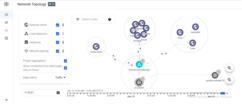| Region Name
|
Launch Date
|
Location
|
Zones
|
| us-west1
|
2016-Q3
|
The Dalles, Oregon, US
|
- us-west1-a
- us-west1-b
- us-west1-c
|
| us-west2
|
2018-Q3
|
Los Angeles, California, US
|
- us-west2-a
- us-west2-b
- us-west2-c
|
| us-west3
|
2020-Q1
|
Salt Lake City, Utah, US
|
- us-west3-a
- us-west3-b
- us-west3-c
|
| us-west4
|
2020-Q2
|
Las Vegas, Nevada, US
|
- us-west4-a
- us-west4-b
- us-west4-c
|
| us-central1[43]
|
2009
|
Council Bluffs, Iowa, US
|
- us-central1-a
- us-central1-b
- us-central1-c
- us-central1-f
|
| us-east1
|
2015-Q4
|
Moncks Corner, South Carolina, US
|
- us-east1-b
- us-east1-c
- us-east1-d
|
| us-east4
|
2017-Q2
|
Ashburn, Virginia, US
|
- us-east4-a
- us-east4-b
- us-east4-c
|
| us-east5
|
2022-Q2
|
Columbus, Ohio, USA
|
- us-east5-a
- us-east5-b
- us-east5-c
|
| us-south1
|
2022-Q2
|
Dallas, Texas, US
|
- us-south1-a
- us-south1-b
- us-south1-c
|
| northamerica-northeast1
|
2018-Q1
|
Montréal, Canada
|
- northamerica-northeast1-a
- northamerica-northeast1-b
- northamerica-northeast1-c
|
| northamerica-northeast2
|
2021-Q3
|
Toronto, Canada
|
- northamerica-northeast2-a
- northamerica-northeast2-b
- northamerica-northeast2-c
|
| southamerica-east1
|
2017-Q3
|
São Paulo, Brazil
|
- southamerica-east1-a
- southamerica-east1-b
- southamerica-east1-c
|
| southamerica-west1
|
2021-Q3
|
Santiago, Chile
|
- southamerica-west1-a
- southamerica-west1-b
- southamerica-west1-c
|
| europe-west1
|
|
St. Ghislain, Belgium
|
- europe-west1-b
- europe-west1-c
- europe-west1-d
|
| europe-west2
|
2017-Q2
|
London, UK
|
- europe-west2-a
- europe-west2-b
- europe-west2-c
|
| europe-west3
|
2017-Q3
|
Frankfurt, Germany
|
- europe-west3-a
- europe-west3-b
- europe-west3-c
|
| europe-west4
|
2018-Q1
|
Eemshaven, Netherlands
|
- europe-west4-a
- europe-west4-b
- europe-west4-c
|
| europe-west6
|
2019-Q1
|
Zurich, Switzerland
|
- europe-west6-a
- europe-west6-b
- europe-west6-c
|
| europe-west8
|
2022-Q2
|
Milan, Italy
|
- europe-west8-a
- europe-west8-b
- europe-west8-c
|
| europe-west9
|
2022-Q2
|
Paris, France
|
- europe-west9-a
- europe-west9-b
- europe-west9-c
|
| europe-west10
|
2023-Q3
|
Berlin, Germany
|
- europe-west10-a
- europe-west10-b
- europe-west10-c
|
| europe-west12
|
2023-Q1
|
Turin, Italy
|
- europe-west12-a
- europe-west12-b
- europe-west12-c
|
| europe-central2
|
2021-Q2
|
Warsaw, Poland
|
- europe-central2-a
- europe-central2-b
- europe-central2-c
|
| europe-north1
|
2018-Q2
|
Hamina, Finland
|
- europe-north1-a
- europe-north1-b
- europe-north1-c
|
| europe-southwest1
|
2022-Q2
|
Madrid, Spain
|
- europe-southwest1-a
- europe-southwest1-b
- europe-southwest1-c
|
| me-west1
|
2022-Q4
|
Tel Aviv, Israel
|
- me-west1-a
- me-west1-b
- me-west1-c
|
| me-central1
|
2023-Q2
|
Doha, Qatar
|
- me-central1-a
- me-central1-b
- me-central1-c
|
| me-central2[44]
|
2023-Q4
|
Dammam, Saudi Arabia
|
- me-central2-a
- me-central2-b
- me-central2-c
|
| asia-south1
|
2017-Q4
|
Mumbai, India
|
- asia-south1-a
- asia-south1-b
- asia-south1-c
|
| asia-south2
|
2021-Q2
|
Delhi, India
|
- asia-south2-a
- asia-south2-b
- asia-south2-c
|
| asia-southeast1
|
2017-Q2
|
Jurong West, Singapore
|
- asia-southeast1-a
- asia-southeast1-b
- asia-southeast1-c
|
| asia-southeast2
|
2020-Q2
|
Jakarta, Indonesia
|
- asia-southeast2-a
- asia-southeast2-b
- asia-southeast2-c
|
| asia-east1[45]
|
2013-Q4
|
Changhua County, Taiwan
|
- asia-east1-a
- asia-east1-b
- asia-east1-c
|
| asia-east2
|
2018-Q3
|
Hong Kong
|
- asia-east2-a
- asia-east2-b
- asia-east2-c
|
| asia-northeast1
|
2016-Q4
|
Tokyo, Japan
|
- asia-northeast1-a
- asia-northeast1-b
- asia-northeast1-c
|
| asia-northeast2
|
2019-Q2
|
Osaka, Japan
|
- asia-northeast2-a
- asia-northeast2-b
- asia-northeast2-c
|
| asia-northeast3
|
2020-Q1
|
Seoul, Korea
|
- asia-northeast3-a
- asia-northeast3-b
- asia-northeast3-c
|
| australia-southeast1
|
2017-Q3
|
Sydney, Australia
|
- australia-southeast1-a
- australia-southeast1-b
- australia-southeast1-c
|
| australia-southeast2
|
2021-Q2
|
Melbourne, Australia
|
- australia-southeast2-a
- australia-southeast2-b
- australia-southeast2-c
|
| africa-south1[46]
|
2024-Q1
|
Johannesburg, South Africa
|
- africa-south1-a
- africa-south1-b
- africa-south1-c
|


